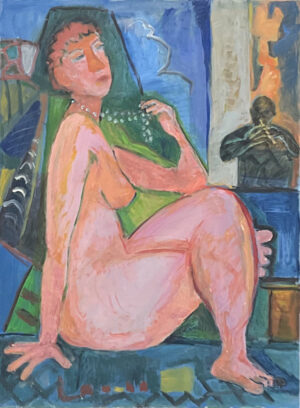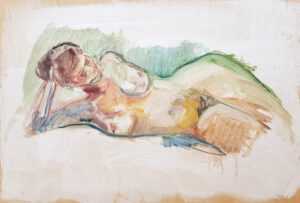Description
Heinz te Laake: * 1925, Berlin † 2001, Rheingau
Execution: Acrylic on canvas
Date: 1994
Dimensions: 60 x 50 cm
Signed: bottom right
Provenance: Original work from artist’s estate.
Heinz te Laake studied from 1945 to 1950 at the Hochschule für Bildende Künste in Berlin with Karl Schmidt-Rottluff. The artist undertook longer study trips through Europe, and deepened his painterly knowledge of the classics with longer study visits to the Louvre in Paris and the National Museum in Athens. He then settled as a freelance artist, first in Düsseldorf, later at Schloss Reinhartshausen in the Rheingau, in a studio apartment together with his wife Marlis te Laake. In addition to his painting, since 1957 he has been developing kinetic objects, moving images and sculptures with clockwork movements, which can now be found in many international collections, including the Stedelijk Museum in Amsterdam and the Musée des Arts Decoratifs in Lausanne. The collector Theodor Ahrenberg particularly appreciated the artist’s painterly works. Heinz te Laake spent several stays in his studio Le Rocher in Chexbres. There he painted and lived, getting to know numerous artists, as well as art patrons.
Te Laake always deals with themes of applied art and designed, in addition to clocks, collector porcelains, table decorations, including for Ritzenhoff and artist labels for various Rheingau wineries, in addition to Schloss Reinhartshausen namely for the winery Balthasar Rees. Te Laake’s work is inspired by the figurative style of classical modernism as well as its colorful, expressive visual language. The colorful ductus of his teacher Schmidt Rottluff shines through again and again. His style and motifs are reminiscent of Cocteau ́s delicate, self-assured line and Matisse’s conception. Heinz te Laake creates works in the 60s and 70s, which are entirely in the expression and attitude to life of the Pop Art movement of those years. The time of upheaval, sexual freedom, the fascination of Easy Rider ́s brings te Laake decoratively and with great, dynamic impulse on the canvas. He remains true to this style in the following decades.




